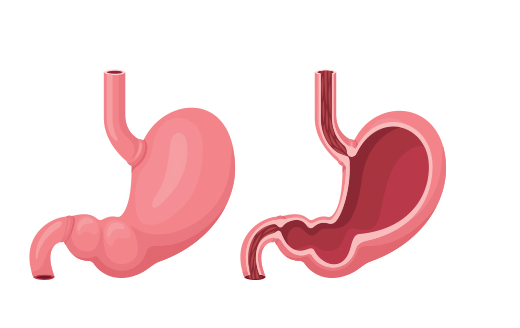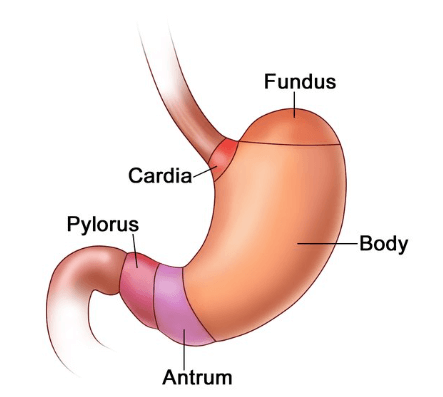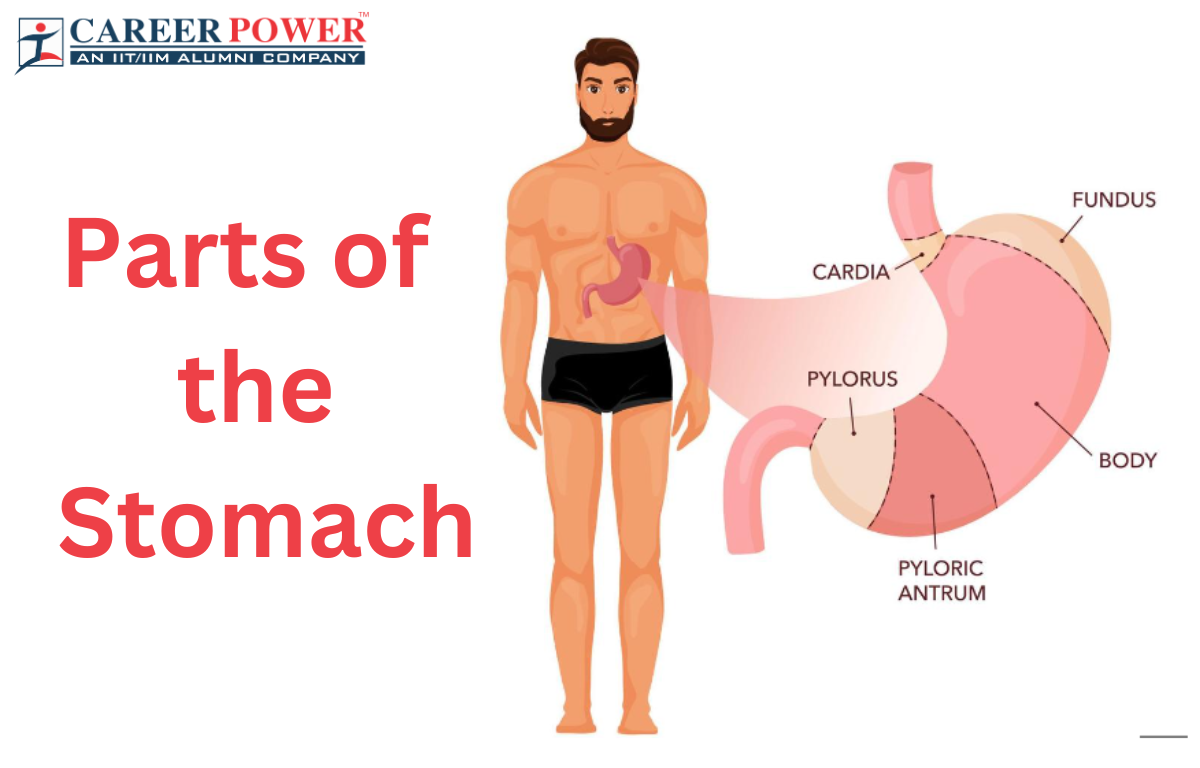The parts of the stomach are the most important topic from class 11th Unit 5 “Human Physiology” in Biology. As we already know that the Stomach is one of the most important parts of the digestive system. After slight digestion of the food in the mouth, the esophagus carries the food to the stomach for further digestion. The food in the stomach takes three hours to be churned. During this time, the food breaks down into still smaller pieces and forms a semi-solid paste. There are three tubular glands in the walls of the stomach. The glans present in the walls of the stomach secrete gastric juices.
The gastric juices contain three substances: hydrochloric acid, the enzyme pepsin, and mucus. Due to the presence of hydrochloric acid, gastric juice is acidic in nature. In the acidic medium, the enzyme pepsin begins the digestion of proteins present in food to form smaller molecules. Thus, protein digestion starts in the stomach. The mucus helps to protect the stomach wall from its own secretion of HCl. The partially digested food from the stomach then enters the small intestine.
Definition of Stomach
The Stomach is a J-shaped organ which is located on the left side of the abdomen. It is a 4 part organ that contains two openings (esophagus and duodenum). The stomach plays a key role in the digestion of food. As the stomach receives and stores food, then mixes it with digestive juices to break it down into smaller particles for further processing in the intestines. Just like you use your toy building blocks to build things, the stomach helps your body build energy and grow with the food you eat.

Functions of a Stomach
The stomach plays a crucial role in digestion, but its main functions are to mechanically break down food, mix it with digestive juices, and initiate the digestion of proteins.
- Mechanical Breakdown: The stomach helps break down ingested food into smaller particles through muscle contraction. and churning.
- Mixing: It mixes food with gastric juices, creating a semi-liquid mixture called chyme.
- Acid Secretion: The stomach secretes hydrochloric acid, which activates enzymes and aids in digestion.
- Kill Microorganisms: The acidic environment of the stomach helps kill potentially harmful microorganisms.
- Limited absorption: Some substances, like water, electrolytes, and certain drugs, can be absorbed in small amounts.
- Regulation of Emptying: The stomach regulates the rate at which chyme enters the small intestine for further digestion.
- Production of Intrinsic Factor: The stomach produces intrinsic factors, essential for the absorption of vitamin B12 in the small intestine.
- Gastric Hormone Secretion: Hormones like gastrin are released, controlling gastric acid secretion and other digestive processes.
Parts of the Stomach
As we already discussed that the stomach has four main parts: the Cardiac, Fundus, Body, and Pylorus. The Cardiac is the top part that connects to the esophagus, where food enters the stomach. The Fundus is next and holds the gases that are made during digestion. The Body is the largest part of the stomach, where most of the food is mixed and broken down. It is the area where most of the digestion occurs; and the pylorus, which connects to the small intestine and controls the release of Chyme.

Finally, the Pylorus is the lower part, which helps move the digested food into the small intestine. The Pylorus is further divided into two parts: the pyloric antrum and the pyloric canal. All these parts work together to digest food and turn it into energy for the body
| Parts of the Stomach | |
| Name of the parts | Description |
| Cardiac | The cardiac part of the stomach connects to the esophagus. It helps in receiving food from the esophagus. |
| Fundus | The fundus is located in the upper portion of the stomach. It stores gases produced during the digestion process. |
| Body | In this part of the stomach, most of the digestion occurs. As the body mixes and breaks down food with gastric juices. |
| Pylorus | It connects the stomach to the small intestine and also helps in the regulation of chyme flow. |
1. Cardiac
The cardiac part of the stomach, also known as the cardiac region is the area located near the opening of the stomach, where the esophagus connects to the stomach. The cardiac region plays a role in receiving food from the esophagus and also allows it to enter the stomach for further digestion.
Functions of the Cardiac
The cardiac part’s main function is to facilitate the transition of food from the esophagus to the stomach while providing some preliminary protective and digestive functions.
- Reception of Food: The cardiac region receives food from the esophagus, acting as a gateway to the stomach.
- Protection: The cardiac region helps prevent stomach acid and enzymes from flowing back into the esophagus, thanks to the lower esophageal sphincter.
- Initiation of digestion: Although limited, some enzymes and chemical digestion begins in this region due to the presence of mucous cells that secrete protective mucus.
- Sphincter Function: The lower esophageal sphincter, located here, prevents gastric content from regurgitating into the esophagus and helps maintain proper pressure within the stomach.
- Gastric Relaxes: The cardiac region, along with the rest of the stomach, is involved in triggering reflexes that regulate gastric emptying and control the movement of food into the intestines.
2. Fundus
The fundus is the upper portion of the stomach that lies above the level of the cardiac (where the esophagus meets the stomach) and below the diaphragm. The fundus region of the stomach is involved in storing and mixing food with gastric juices before gradually releasing it into the rest of the stomach for further digestion.
Functions of the Fundus
All the functions of the fundus region collectively contribute to the early stages of digestion and the preparation of food for further processing in the pylorus of the stomach.
- Intestinal Digestion: The fundus’s acidic environment and enzymatic activity initiate the digestion of carbohydrates and fats.
- Gas Accommodation: The relaxed and expanded state of the fundus region helps accommodate the entry of swallowed air, preventing excessive pressure buildup in the stomach.
- Ghrelin Secretion: The fundus is involved in producing Ghrelin, a hormone that helps in the regulation of hunger and appetite.
- Gastric Motility: The fundus contracts to help mix food with gastric secretions, creating a semi-liquid mixture known as chyme, which is then gradually released into the rest of the stomach for further processing.
- Pepsin Production: It produces pepsin, an enzyme that starts the digestion of proteins by breaking them down into smaller peptide molecules.
- Acid Production: The fundus secretes hydrochloric acid, which plays a crucial role in activating enzymes and creating an acidic environment for digestion.
3. Body
The body region of the stomach is the middle portion between the fundus (upper part) and the pylorus (lower part). The body region contains gastric glands that secrete HCl, enzymes, and mucus. This region of the stomach is responsible for mixing and breaking down food using stomach acid and digestive enzymes.
The muscles in the body region help churn and mix the contents, further breaking down food particles and facilitating their movement toward the pylorus, which is the gateway to the small intestine. The body region plays a crucial role in the initial stages of digestion and nutrient absorption.
Functions of the Body
All the functions of the body region of the stomach that are mentioned below, collectively contribute to the body region’s role in the early stages of digestion and nutrient processing within the stomach.
- Initiation of Reflexes: The presence of food in the body region triggers sensory signals that initiate digestive reflexes, stimulating the further secretion of gastric juices and coordinating the movement of food through the digestive system.
- Storage: The body region can temporarily store food, allowing the digestive system to process smaller amounts of food at a time, which can aid in more efficient digestion and absorption.
- Hormone Secretion: Cells in the stomach lining, particularly the body region, secrete hormones like Ghrelin, which stimulates hunger, and Somatostatin which regulates the release of gastric juices.
- Control of gastric Emptying: The body region controls the gradual release of chyme into the small intestine through the pyloric sphincter. This helps prevent overwhelming the small intestine with a large volume of undigested material at once.
- pH Regulation: The body region helps regulate the pH level of the stomach by producing hydrochloric acid. This acidic environment is essential for the activation of digestive enzymes and the proper functioning of the stomach’s digestive processes.
4. Pylorus
The pylorus is the lower portion and the last section of the stomach that connects to the small intestine. The Pylorus region of the stomach consists of two main parts: the pyloric antrum, which is closer to the body region of the stomach; and the pyloric canal, which is a narrow part that leads into the small intestine. The pylorus region includes the pyloric sphincter, a muscular ring located at the junction between the stomach and the small intestine. The pyloric sphincter serves as a valve that controls the flow of partially digested food called chyme from the stomach into the small intestine, allowing for controlled digestion and absorption.
Functions of the Pylorus
The pylorus and its associated functions play a vital role in ensuring effective digestion, nutrient absorption, and overall health of the digestive system.
- Chyme Mixing: The pylorus aids in mixing the partially digested food called chyme with digestive enzymes, and gastric juices, ensuring thorough mixing and uniform distribution of nutrients for efficient digestion.
- Enzymatic Activation: The pylorus ensures that chyme is released into the small intestine at a controlled rate, allowing digestive enzymes from the pancreas and bile from the gallbladder to mix with the chyme for further digestion.
- Acidic Chyme control: The pylorus helps prevent highly acidic chyme from the stomach from entering the small intestine too quickly. This helps protect the delicate lining of the intestine from potential damage.
- Hormone Regulation: The presence of chyme in the small intestine triggers the release of hormones like cholecystokinin (CCK) and secretin. These hormones stimulate the pancreas to release digestive enzymes and the gallbladder to release bile.
- Prevents bacterial growth: The pylorus aids in preventing excessive bacterial growth in the small intestine by regulating the flow of chyme. This helps maintain a balanced microbial environment.



 50 Vegetables Name for Kids in English a...
50 Vegetables Name for Kids in English a...
 Food Chain: Definition, Types, Examples,...
Food Chain: Definition, Types, Examples,...
 Human Respiratory System: Definition, Di...
Human Respiratory System: Definition, Di...













